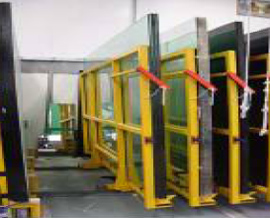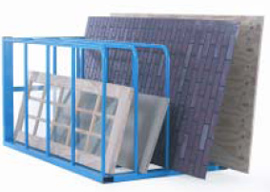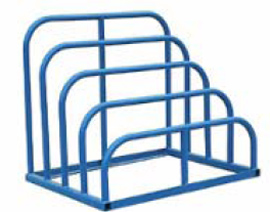Injury to young worker caused by racking system failure
In June 2023, a young worker was seriously injured when welded mesh sheets fell onto him.
Early investigations found that the worker was assisting a forklift operator in the process of moving 19 mesh sheets from the ground into stillage (storage racking). The pair were guiding the sheets into the stillage (3-4 at a time). At the completion of the process, it appears the injured worker moved to the back of the stillage when it failed and collapsed on them causing serious internal injuries.
These findings are not yet confirmed, and investigations are continuing into the exact cause.
Safety issues
Sheet materials, such as timber, stone and glass, can fall and cause serious injury if they are not adequately supported while being transported, handled, or stored. The risk of severe or fatal injuries is high when these materials are stacked on their edges and not adequately supported, restrained, or secured from falling by suitable storage racking or transport frames.
Overloading or sudden movement of heavy items can impart unsafe static or dynamic loads to racking systems.
In addition, workers risk musculoskeletal injuries caused by strenuous activity or unexpected movements when heavy items move or change position suddenly while being handled.
Ways to manage health and safety
Effective risk management starts with a commitment to health and safety from those who manage the business. If an incident occurs, you'll need to show the regulator that you’ve used an effective risk management process. This responsibility is covered by your primary duty of care in the Work Health and Safety Act 2011.
Use the hierarchy of controls to help decide how to eliminate and reduce risks in your place of work.
The hierarchy of controls ranks types of control methods from the highest level of protection and reliability to the lowest. It’s a step-by-step approach to eliminating or reducing risks. You must work through the hierarchy of controls when managing risks, with the aim of eliminating the hazard, which is the most effective control.
Possible control measures to prevent similar incidents
Effective control measures for storing heavy objects (such as welded mesh sheets), are often made up of a combination of controls. The WHS Regulation requires duty holders to work through the hierarchy of control measures when managing certain risks.
Some common risk control measures can include:
- Eliminate stacking sheets vertically by laying sheets on a flat surface horizontally rather than leaning them against a wall or structure.
- Using a rack or transport frame to securely store, cradle, lift, transport and restrain sheet materials.
- Using racks and transport frames (including trolleys) that are designed and certified for the loads applied in use, including whether they are designed to be freestanding or required to be securely attached to the ground or other structures.
- Selecting trolleys based on the loads to be moved and the ground conditions at the workplace.
- Including connection points for restraints to ensure the loads remain stable while moving and storing.
- Selecting racks that have been designed for forces resulting from unbalanced loads. Examples of racking and storage systems for sheet materials are shown in photographs 1, 2, and 3.

Figure 1: An example of a storage system for large panels

Figure 2: An example of storing panels of varying sizes

Figure 3: An example of a stacking frame
Racking systems and things to be aware of:
- Ensure the use of adequate load rated restraint equipment.
- Racking systems should be set up, operated, and maintained according to the instructions of the racking manufacturer, and be in accordance with AS 4084.1:2023 - Steel racking systems.
- The system should be designed specifically for the size, shape, and weight of the products being stored.
- Racking should also be compatible with the pallets and the material handling equipment used in the workplace.
- For example, aisle width should be matched to the turning circle of the forklift used for picking and replenishment.
- Any modifications to the racking system should be checked by the original supplier/manufacturer/designer.
- Ensuring racking systems and other plant and equipment at the workplace are inspected, maintained, and repaired according to the manufacturer’s recommendations and specifications. Plant inspection should be conducted in accordance with a regular maintenance system to identify:
- Deficiencies in the equipment associated with use of the plant (wear and tear, corrosion, and damaged plant parts).
- Adverse effects of changes in processes or materials associated with plant.
- Inadequacies in control measures that have been previously implemented.
- Racking systems should be inspected frequently for damage and overloading, and at least annually to check its integrity.
- Consulting with the manufacturer, workers, and others involved in the work, to obtain feedback on the plant and associated work processes and safe work procedures.
- Providing information, training, instruction, and supervision to workers who use the trolleys and other plant/equipment. This includes the development of safe work procedures in accordance with the manufacturer’s instructions that are suitable and adequate to:
- The nature of the work to be carried out by the worker.
- The nature of the risks associated with the work (at the time the information, training, or instruction is provided).
- The control measures implemented to deal with these risks.
- Information available should include the rating for equipment, such as racking systems, that is used at the workplace and what loading limits may apply based on the products.
Adopting and implementing higher order controls, before considering administrative or Personal protective equipment (PPE) controls, will significantly reduce the likelihood of a similar incident occurring. The control measures you put in place should be reviewed regularly to make sure they work as planned.
Young workers
Business owners must also ensure the work environment, and the way young employees do their job, is safe and healthy, regardless of the type and terms of their employment. Employers of young workers should:
- understand young workers' risk profile
- ensure a safe and healthy workplace
- provide information, training, instruction and supervision, and
- develop a positive workplace culture.
Consider the tasks you give to new and young workers given their skills, abilities, and experience. Before a young person begins work, a PCBU should:
- Identify the gaps in the worker's knowledge and assess their ability to work safely (competency should be tested).
- It is not sufficient to accept a young worker's assurance that he or she is experienced and competent.
It's important for young workers to actively participate in the way work health and safety is managed. This means they need to take induction and training seriously, use the risk management process for work tasks, and ask for help before starting a task they're not familiar with or comfortable carrying out.
More information
- Managing risks of plant in the workplace code of practice 2021 (PDF, 1.57 MB)
- Hazardous manual tasks code of practice 2021 (PDF, 1.38 MB)
- How to manage work health and safety risks code of practice 2021 (PDF, 0.65 MB)
- Storage and handling of sheet materials - Alert
- Young workers
- Young worker safety toolkit (PDF, 4.59 MB)
Have you been affected by a workplace fatality, illness or serious injury?
For advice and support: